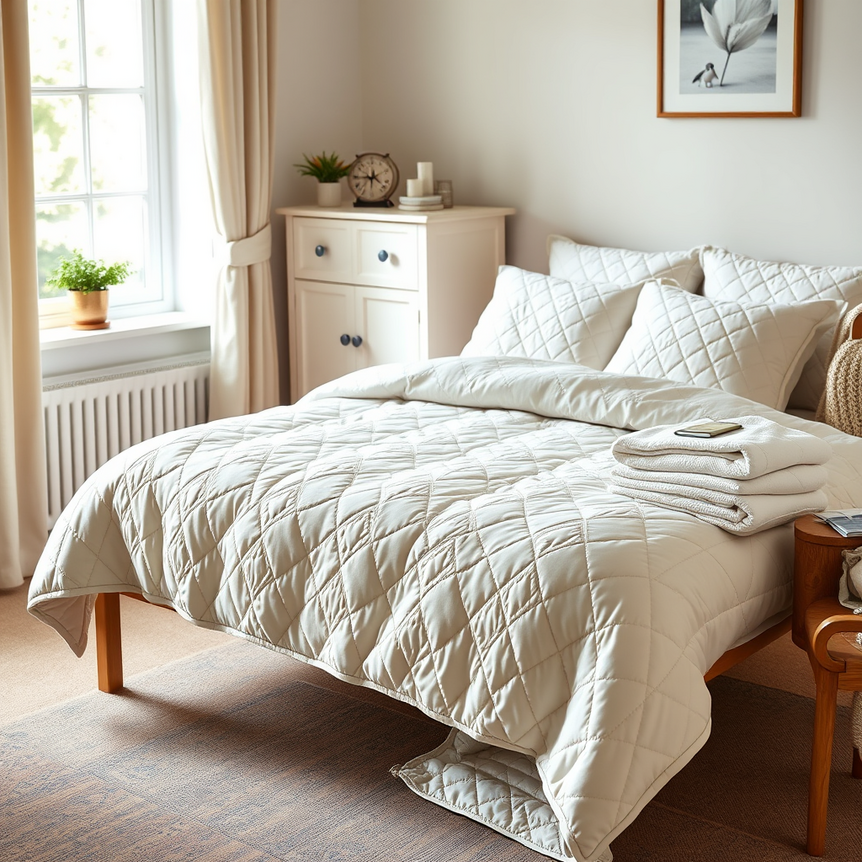Quilt bedspread sets add warmth, texture, and character to your bedroom but require specific care to maintain their beauty and longevity. Whether your quilt is a cherished heirloom or a stylish modern piece, proper washing and care adapted to UK homes can preserve its fabric integrity and vibrant colours. This comprehensive guide will walk you through fabric considerations, cleaning steps, drying, storage, and recommended products to help you keep your quilt bedspread set in pristine condition.
Understanding Your Quilt Bedspread Set: Fabric Types and Care Needs
Quilt bedspread sets commonly feature fabrics such as 100% cotton, cotton blends, polyester, or sometimes delicate fibres like silk or linen. Each fabric type demands a tailored care approach:
- Cotton quilts are sturdy and generally machine washable, but hot water or harsh detergents can shrink or fade the fabric.
- Polyester or blended quilts often handle machine washing well at lower temperatures but benefit from gentler cycles.
- Delicate or vintage quilts with intricate stitching or natural fibres require careful hand washing or professional cleaning.
Knowing your quilt’s fibre content—usually listed on the care label—is essential before cleaning to prevent damage. UK climates with varying humidity levels also influence care decisions, such as opting for machine washing when moisture levels are high to ensure thorough drying and prevent issues like mildew.
Pre-Washing Preparations: Inspecting, Spot Cleaning, and Handling Stains
Before laundering your quilt bedspread set, take these preparatory steps to protect it:
- Inspect for Damage: Check for loose threads, worn areas, or weak seams. Repair them or consult a textile professional to avoid worsening damage during washing. This proactive quilt care ensures longevity.
- Spot Clean Stains: Blot stains immediately with a mild, pH-neutral stain remover or gentle soap mixed with water. Avoid abrasive scrubbing that can break fibres.
- Test Colourfastness: Apply your chosen detergent solution on a small, inconspicuous spot to ensure colours won’t run. This is crucial for maintaining vibrant hues.
- Remove Dust and Debris: Shake out the quilt outdoors or vacuum gently with an upholstery attachment to remove loose dirt and allergens.
These initial steps are vital for maintaining your quilt’s structural and aesthetic quality through the washing process, ensuring effective and safe quilt cleaning.
Step-by-Step Guide to Washing Your Quilt Bedspread Set Safely
Proper washing quilts techniques are key to preserving their quality. Follow these guidelines for machine or hand washing, considering your specific quilt bedspread set.
Machine Washing
- Set Washer to a Gentle or Delicate Cycle: Use the shortest, lowest spin cycle available to reduce stress on fibres and prevent tangling.
- Choose Cold or Warm Water: Cold water preserves colours and prevents shrinking, while warm water (up to 30°C) helps remove dirt from cotton blends without damage. Avoid hot water, especially for delicate fabrics.
- Use Mild Detergent: Pick a gentle, dye-free detergent formulated for delicate fabrics. Avoid bleach or fabric softeners, which can weaken fibres and diminish your quilt’s natural softness.
- Load Carefully: Wash the quilt alone or with similar coloured bedding to avoid friction damage and ensure thorough cleaning.
- Balance Load: Add a couple of towels or sheets of similar weight and colour to balance the machine if the quilt is light, preventing excess agitation and ensuring an even wash.
Hand Washing (For Delicate or Vintage Quilts)
For precious or delicate items, hand laundering quilts is often the safest bet:
- Fill a bathtub or large basin with cold to lukewarm water.
- Add a small amount of mild detergent and gently agitate to create suds.
- Submerge the quilt fully and gently move it through the water for about 10-15 minutes without wringing, twisting, or harsh scrubbing.
- Drain the soapy water and refill with clean, cool water to rinse thoroughly. Repeat rinsing until no suds remain.
- Press out excess water gently against the side of the tub or basin. Avoid wringing or twisting, which can damage stitching and fibres.
Effective Drying Methods to Maintain Quilt Integrity and Freshness
Properly drying quilts is just as important as washing, preserving stitching and preventing mildew—a key consideration in the often damp UK climate. Incorrect drying can lead to shrinkage, damage, or unpleasant odours.
- Line Drying: The ideal method is to air dry your quilt flat on a clean clothesline or a sturdy drying rack in a shaded area to avoid direct UV fading. If hanging, support the quilt evenly across multiple lines to prevent stretching or distortion.
- Indoor Drying: In typical UK weather, outdoor drying might not always be feasible. Use large indoor drying racks, positioned near radiators (but not directly on them to avoid scorching) or in well-ventilated rooms with dehumidifiers. Ensure good air circulation around the quilt.
- Tumble Drying: Suitable for many synthetics and cotton quilts, use a low heat, gentle cycle. Consider using a large capacity dryer to allow the quilt to tumble freely. Add dryer balls (wool or plastic) to maintain loft and prevent clumping of batting, and reduce drying time.
- Avoid Over-Drying: Remove the quilt while it’s slightly damp to finish drying flat indoors. This reduces tension on seams and fabric, preventing unnecessary wear and static build-up. Always ensure the quilt is completely dry before storing to prevent mildew.
Long-Term Storage Solutions for Your Quilt Bedspread Set in UK Climates
Proper storing quilts protects your quilt bedspread set from moisture, pests, fading, and creasing, especially important given the UK’s variable climate which can lead to humidity fluctuations.
- Use Breathable Storage Bags: Cotton, linen, or purpose-made breathable fabric bags are ideal as they allow airflow, preventing the build-up of moisture that can lead to mold and mildew. Avoid airtight plastic bags, which trap humidity and can cause yellowing or deterioration over time.
- Store in a Cool, Dry Place: Choose a closet, airing cupboard, or under-bed storage away from direct sunlight, extreme temperature fluctuations, and damp areas like basements or attics. Consistent temperatures and low humidity are crucial for preserving fabric integrity.
- Acid-Free Tissue Paper: Layer acid-free tissue paper between folds to reduce creasing, protect delicate fibres, and prevent colour transfer, particularly if storing for extended periods.
- Natural Pest Repellents: Place lavender sachets, cedar blocks, or natural moth balls nearby to deter moths and other insects without harsh chemicals. Ensure these do not directly touch the quilt.
- Regularly Air Out: Every 3-6 months, unpack and air your quilt for a few hours on a dry, breezy day or indoors in a well-ventilated space. This keeps fabrics fresh, prevents permanent creases, and allows you to inspect for any signs of damage or dampness.
Recommended Products and Tools to Enhance Quilt Care
To assist in maintaining your quilt bedspread set’s longevity and fresh appearance, consider these curated products that complement effective quilt care practices. Many of these can be found alongside Rugstars UK’s home decor offerings, making it easy to enhance your home’s aesthetic and cleanliness.
- Gentle Fabric Detergents: Brands like Ecover, Woolly Wool detergent, or other eco-friendly, pH-neutral options are ideal for delicate quilt fabrics. Look for formulas free from harsh chemicals, dyes, and strong perfumes.
- Mild Stain Removers: Oxygen-based stain removers that are bleach-free protect fibres during spot cleaning. Always patch test before full application.
- Fabric Fresheners: Light sprays designed for upholstery or delicate bedding can freshen quilts between washes without damaging fibres or leaving residue. Ensure they are non-aerosol and free of heavy perfumes.
- Breathable Cotton Storage Bags: Essential for long-term storage, these bags protect quilts from dust and pests while allowing crucial airflow.
- Wool Dryer Balls: These natural dryer balls reduce drying time, soften quilts naturally without chemicals, and help to fluff up the batting, preventing clumping.
These products complement your quilt maintenance routine while aligning with sustainable UK home care practices, ensuring your quilt bedspread set remains a beautiful and comforting addition to your home.
Frequently Asked Questions About Quilt Bedspread Care
- Q: How often should I wash my quilt bedspread set?
- A: Generally, wash your quilt every 3-6 months, or more frequently if you have allergies or spills. Frequent laundering can accelerate wear, so spot clean when possible to extend its lifespan and maintain its quality.
- Q: Can all quilts be machine washed?
- A: Most modern cotton and polyester quilts can be machine washed on gentle cycles. However, vintage, silk, or heavily embellished hand-stitched quilts should typically be hand washed or professionally cleaned to prevent damage.
- Q: How do I fix small tears or loose stitching on my quilt?
- A: Use a needle and thread matching the quilt colour and fabric to carefully mend small tears or loose stitching. For valuable or antique quilts, or significant damage, it’s best to seek a textile restoration specialist for expert repair.
- Q: What if my quilt smells musty after storage?
- A: Air the quilt outside on a dry, breezy day, away from direct sunlight. You can also use fabric freshener sprays designed for delicate bedding. Persistent musty odours may indicate moisture damage and could require professional cleaning or airing in a room with a dehumidifier.
- Q: Can I iron my quilt bedspread set?
- A: Ironing is generally not recommended for quilts as it can crush the batting, flatten the loft, and potentially weaken stitches. If absolutely necessary for minor wrinkles, use a very low heat setting with a pressing cloth and avoid direct contact with seams and decorative stitching. Steaming might be a gentler alternative.
Caring for your quilt bedspread set ensures it remains a warm, beautiful centerpiece of your bedroom for years to come. For stylish, high-quality quilt sets designed with both comfort and easy care in mind, explore the 3-piece quilt bedspread sets from Rugstars UK. With proper washing, drying, and storage, your quilt will continue to add charm and cosy elegance to your home, enhancing your overall home decor.



